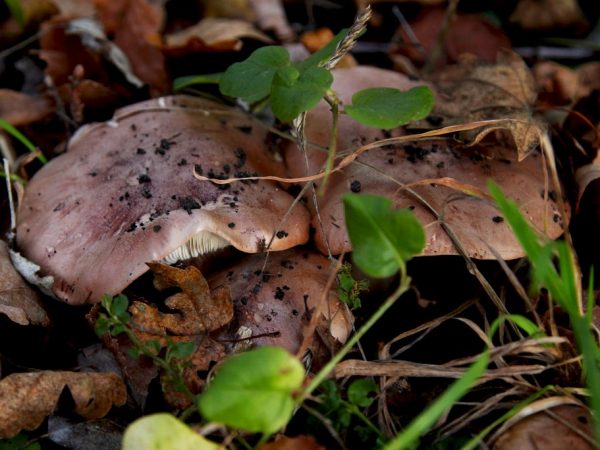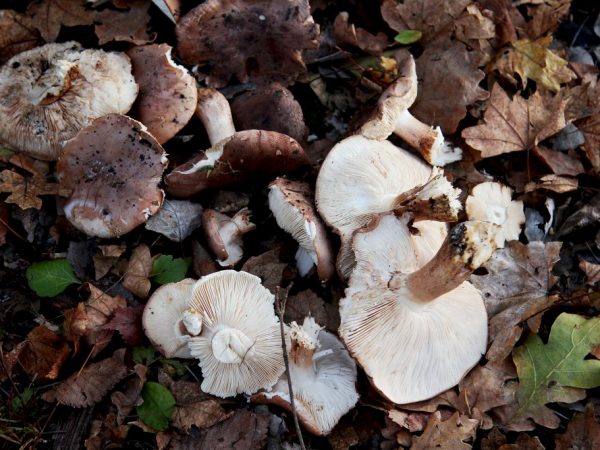Description of the poplar row
In the steppe regions, poplar rowing actively grows in the autumn. This is a conditionally edible mushroom that is harvested for pickling, pickling and frying. It is also called underfloor, sandstone, poplar. The people use the names "frosts", "zabaluyki". The fungus is not found in all types of forests.

Description of the poplar row
What does an underfloor look like
The poplar ryadovka looks like a mushroom with a distinct stem, i.e. having a cap-legged structure. The cap straightens as it grows, becomes fleshy and convex, reaches 18 cm in diameter. The edge of the cap is wavy, along it there is a light border formed by the blanching of the color in this part of the cap. There are no scales on the surface - it is smooth.
Young mushrooms have thin, creamy or white plates. In adults, the color of the plates changes to pink-brown or brown. According to the structure of the hymenophore in the form of plates, they say that this is a lamellar type of spore-bearing layer. The hymenophore firmly adheres to the stem. Spores develop on the surface of the plates. By the way. The color of the surface of the plates can be determined by the presence of spore powder.
The leg grows in length from 2 to 10 cm, and in diameter it is usually no more than 4 cm. Its shape is cylindrical, expanding towards the bottom. At first it is whitish, then it turns reddish brown.
The pulp is fleshy, firm to the touch, white. Under the skin it is dark (brownish). The characteristic smell of ryadovka poplar is flour or soft cucumber.
Poplar rows have the following advantages:
- compact small cap is convenient for pickling and salting;
- young mushrooms have a richer taste;
- mushrooms with caps that have not yet opened are less often wormy.
The poplar row grows in the steppe area, in the poplar forest belts, in a heap, hiding under the foliage. The process of collecting young plants also has a disadvantage. Usually they are deeply "dug" into the ground or covered with leaves, which requires a long time to clean them of dirt. Rows grow in large groups from August to October.
Irina Selyutina (Biologist):
I cannot but agree that the poplar rower is inherent in the ability to go through its entire development cycle without appearing above the soil surface. Very often, these mushrooms are simply raised with sod caps. Having found one mushroom, you can be 100% sure that you can look for other members of the "family" nearby, because they never grow alone.
Growing in large groups, floodplains can appear around poplars in parks or forest belts, or along roads, ravines, or near ponds. Having chosen a place for itself, one group (or rather the population) over the next few years will occupy a whole clearing near the chosen tree. This species prefers loose and dry soil, therefore it is most often found on sandy soils.
Advice. Collect only young specimens, i.e. those that have not yet straightened their hat and the plates have a pinkish tone.
Geographically, the species is distributed in the steppes of the Volgograd, Saratov, Omsk regions, Altai Territory and Kazakhstan.The species is especially appreciated in the steppe regions, but in the forest regions this species is not so popular among the mushroom picker, spoiled by various "mushroom snacks".
Related species of mushroom
In protective forest belts and steppes, the Ryadovka or Tricholoma genus are represented by the following species:
- R. purple;
- R. gray;
- R. green;
- R. purple-footed;
- R. giant;
- R. crowded;
- R. yellow-red.
Descriptions of species differ mainly only in the color of the cap and leg. The purple row is called "cyanosis". Initially, a deep purple color of the cap in a young individual, in the process of maturation, changes to lavender. Unlike other species, it has a flatter cap shape.
Gray and crowded rows are considered the most delicious types. The crowded row grows in conglomerates, uniting at the level of fruit bodies. It is difficult to separate them, therefore, the entire joint is cut off at once.
The green row has a characteristic light green color of the cap, and in the lilac-legged row, only the leg is painted purple.
The yellow-red ryadovka is considered the least tasty. During the season, almost all types of fungi are found in the same forest. If there is no confidence in the edibility of the trophies found, it is better not to cut them off.
Attention! Very often, instead of a ryadovka poplar, inexperienced mushroom pickers collect its relative - a ryadovka ciliated, which can cause a disorder of the gastrointestinal tract when eaten. To prevent this from happening, remember that the poplar row does not grow under coniferous trees.
Beneficial features

Mushrooms contain useful trace elements
The poplar ryadovka species contains a lot of useful substances. Its pulp contains a lot of fiber, which detoxifies the body. It also contains trace elements: magnesium, potassium, manganese, sodium. The presence of vitamin C has been recorded.
The product is low in calories (about 25 kcal per 100 g), therefore it is indicated for diets. In addition, due to the presence of fiber in these mushrooms, a person is quickly saturated with them and does not experience hunger for a long time.
Contraindications to use
You should not eat ryadovka poplar if you have problems with the gastrointestinal tract or liver. Children under 7 years old are not given such products at all. Reducing the risk of poisoning will be achieved through proper processing and compliance with collection rules:
- Do not pick edible fruiting bodies from dirty areas.
- Do not cut the mushroom unless you are sure of its edibility.
- At home, re-sort the collected trophies and cut off suspicious places.
For your information. To be sure that the collected mushrooms do not carry the products of human activity, go into the forest at a depth of at least 500 m, even if you have to miss the enticing meadows with rows.
In case, nevertheless, poisoning has occurred, at the first sign of it, they consult a doctor.
Application
After all the procedures for the preparation of fruits, it is allowed to use them in everyday life and for food. The poplar row is used in cooking and folk medicine.
Cooking
The poplar row, like another conditionally edible forest mushroom, goes through several stages of processing:
- Soaking in cold water for several days.
- Boil for at least 15 minutes in boiling water.
- Washing fruit bodies under running water.
Irina Selyutina (Biologist):
Before soaking, the poplar row must be processed. Here the difficulty lies in their thorough cleaning from forest debris and earth. In order for the cleaning to be of high quality, it is better to take a soft brush, and clean the plates with the tip of a knife. If this preliminary part is done in bad faith, then your rest of the work will not save the situation - the banks will explode.
The container with mushrooms should be stored at a temperature not exceeding + 16 ° С. After that, they are pickled, salted or fried.
Mushroom caviar is also made from forest mushrooms. To cook it, boiled pulp (without legs) is chopped with a blender or using a meat grinder, stewed with onions, vegetables and spices.
They are harvested for the winter in deep freeze (boiled), thawed immediately in soup or in a frying pan. Fleshy hats go well with porridge, baked potatoes, and a side dish of vegetables.
In folk medicine
Poplar broths are not used as a medicine. Infusions on fruiting bodies are also not recommended to be consumed without first consulting a doctor. Extracts for creams and ointments are partially used in cosmetology, but it is impossible to prepare them at home.
Growing methods
The Ryadovka poplar mushroom lends itself well to growing on a plot or a prepared artificial mycelium. To grow a forest mushroom on your own site, you need a substrate. It is prepared from a mixture of peat, soil and soil for plants. For 5 kg of substrate take:
- 100 g of chalk;
- 1 liter of water;
- 50 g mycelium.
After the substrate is ready you need to:
- mix the substrate and mycelium;
- place the substrate on the beds in a darkened place (poplar rows are planted in conditions close to natural - under a tree);
- the area is regularly moistened, the temperature should not fall below + 20 ° С;
- After 2-3 weeks, add a 5 cm layer of earth and repeat the procedure.
In another couple of weeks, the first fruiting bodies will appear. After each harvested batch, the soil layer is increased by an average of 5 cm. In the fall, when the temperature has dropped below + 5 ° C, the bed is prepared for wintering. Cover it with a cloth, spread a 10 cm layer of straw or dry leaves on top.
Poplar trees are also grown indoors. Conditions are created there that are as close to natural as possible. For this, a lighting and ventilation system, which is important for the vital processes of mushrooms, is created. Fruiting in this cultivation option will begin only after 4 months.
Conclusion
Poplar ryadovka grows in temperate steppe zones. Related species of the underfloor differ in the shape of the caps and color, there are even fruit bodies with a blue and green color. They are mainly used in cooking: traditional medicine does not offer recipes with this species. The culture is adaptive and easy to grow on site or in closed myceliums.



